A Look at Every Omega Dark Side of the Moon Speedmaster
In the early 1980s, with the release of the rare “Black Tulip” quartz Seamaster, Omega became the second watch brand ever–behind only Rado–to make a watch with a ceramic-metal composite case. And when the Omega Dark Side of the Moon Speedmaster debuted in 2013, that made Omega the sixth company to make a watch with a fully ceramic case. The “DSOTM” was a big deal when it first came out, but a slew of variants within the “Side of the Moon” family–as well as growing competition in the ceramic luxury watch space in general–has since watered down the hype. But Omega released some updated variants in 2025, so we’ll go over every Omega Dark Side of the Moon Speedmaster release (and discontinuation).
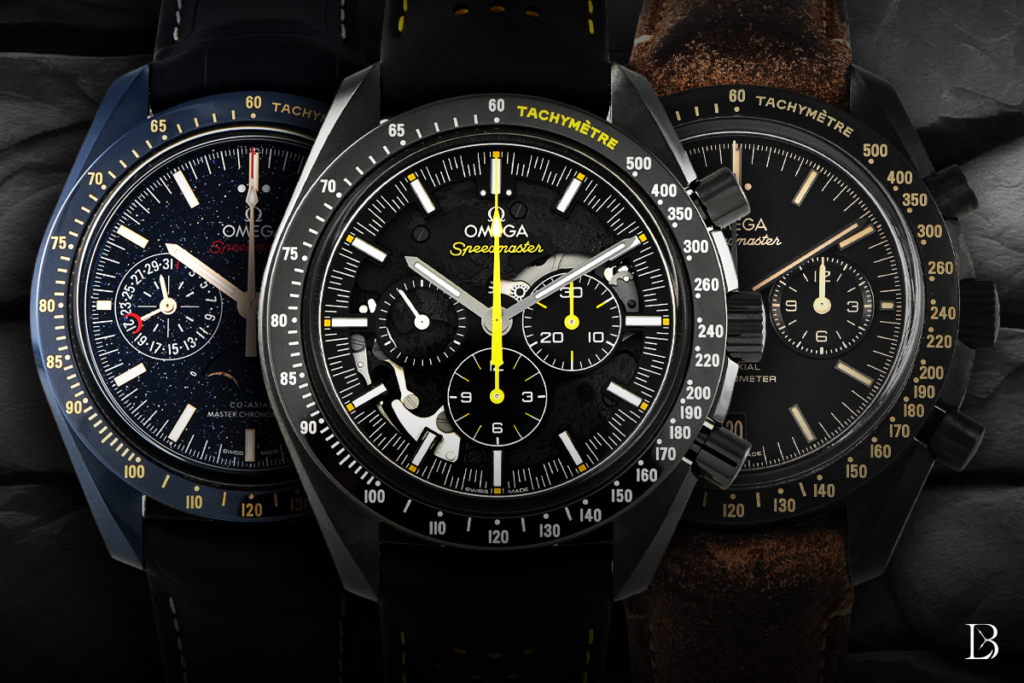
Overview
All “Side of the Moon” Omega Speedmaster models have ceramic cases with widths of 44.25mm, exhibition casebacks, and straps (no bracelets). 18 styles have been made over the years, six of which are still available from Omega today. ZrO2 imprinted on the dial lets you know that the dial is made of zirconium dioxide (ceramic).
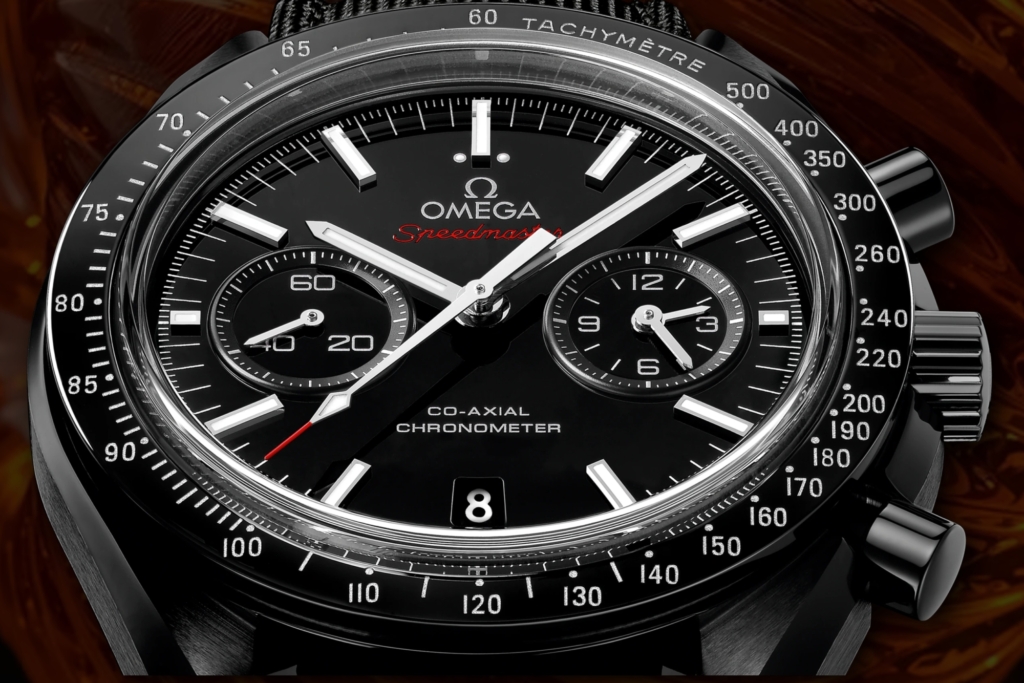
Eleven have been made in black ceramic, three have been made in grey and two each have been made in white and blue ceramic. Most of them are two-register chronographs with automatic co-axial Caliber 9300 movements and 60 hours of power reserve, but there are exceptions. Let’s start with the black ceramic ones.
Black Ceramic Omega Dark Side of the Moon Models
When Omega released the first Speedmaster Dark Side of the Moon in 2013, it was a hit. Watches with fully ceramic cases were far less common then–only IWC, Rado, Panerai, Chanel, and Richard Mille had made them at that point. So the original DSOTM was novel, and it sold very well.
But of course Omega couldn’t just let that success be, so they wasted no time expanding the lineup. After releasing the Grey Side of the Moon in 2014, Omega unveiled four additional colorways of the Dark Side of the Moon in 2015: Pitch Black (all the numbers and text are luminous), Black Black (what it sounds like, black-on-black), Vintage Black (tan text and accents) and Sedna Black (rose gold bezel and accents on a charcoal dial).
All Dark Side of the Moon Models 2013-2024
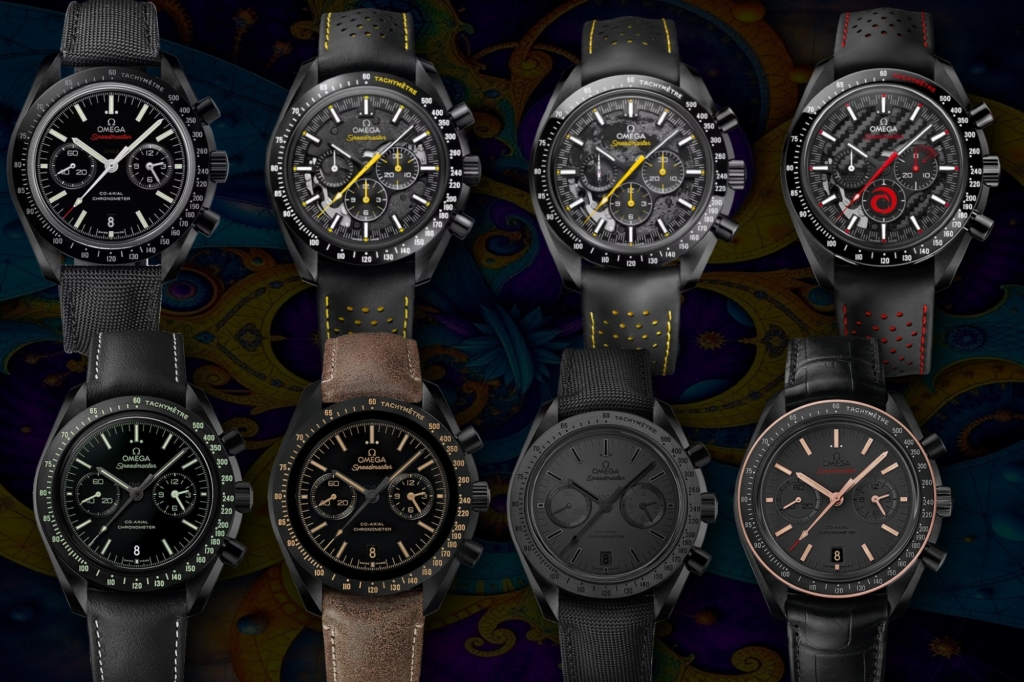
Instead of sending collectors into a frenzy, the new options did the exact opposite–the original Omega Dark Side of the Moon no longer felt like a special, unique thing. And because the four new colorways were so redundant, there was no clear “hot” one among them, and the hype just…faded away. Seeing a lume shot of the Pitch Black is pretty cool though.
Don’t get me wrong; I think all the colorways look cool individually. But Harvard Business School could use the first generation of Omega DSOTM options as a case study in luxury option oversaturation.
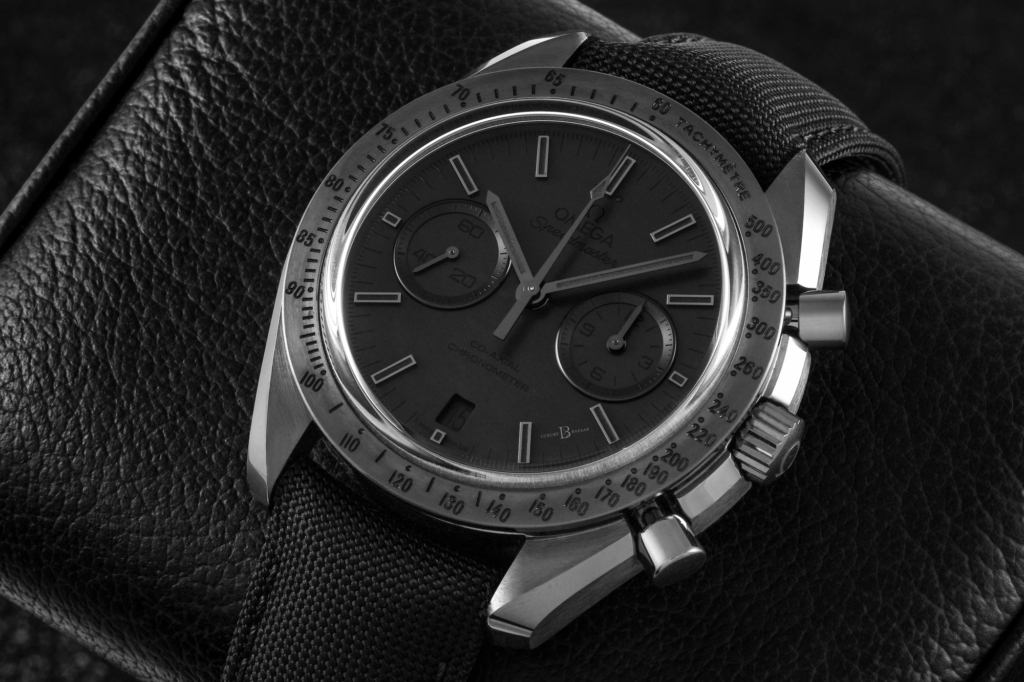
Dark Side of the Moon 2025 Releases

By 2025, Omega’s non-Master Chronometer caliber 9300 movements were aging, so it wasn’t a surprise when an updated generation of Dark Side of the Moon models appeared. The addition of a “step dial,” meaning the dial “steps down” around the minute track, was a nice surprise, however. The subdials are more deeply recessed as well, helping to add more depth to an already nice ceramic dial.
Sedna Gold, Vintage Black, and Pitch Black colorways all were discontinued in 2025. The classic DSOTM and Black Black versions got upgraded caliber 9900 movements, and got a new rubber strap option. Technically this 2nd-generation “Black Black” model is now called “Dark Black.” And, notably, the Dark Black has DLC on the plates and bridges of its movement, which Omega calls 9900 Black Edition.

Plus a new Dark Red a.k.a. “Dark Vader” colorway appeared with black fill on the hands/markers and a red seconds hand. Somewhat unexpectedly the Dark Vader has a manual-wind caliber 9908 movement that lacks a date, and it also gets the Black Edition treatment. For whatever reason the Dark Vader doesn’t have a factory nylon strap option, so rubber is mandatory.

That covers the two-register black ceramic Omega Dark Side of the Moon Speedmasters, but there have also been three partially skeletonized manual-wind three-register releases.
Manual-Wind Three-Register DSOTM Models
There are two “Apollo 8” editions (the 2018 original and the updated 2024 release), along with the red-accented special “Alinghi” edition made in 2020 to celebrate Omega’s partnership with that renowned sailing team. On the Alinghi DSOTM, the Alinghi logo acts as the chronograph hour hand. Inside is the caliber 1865, a specially decorated version of the trusty 1861 with a black carbon fiber-like woven pattern on some of the plates.
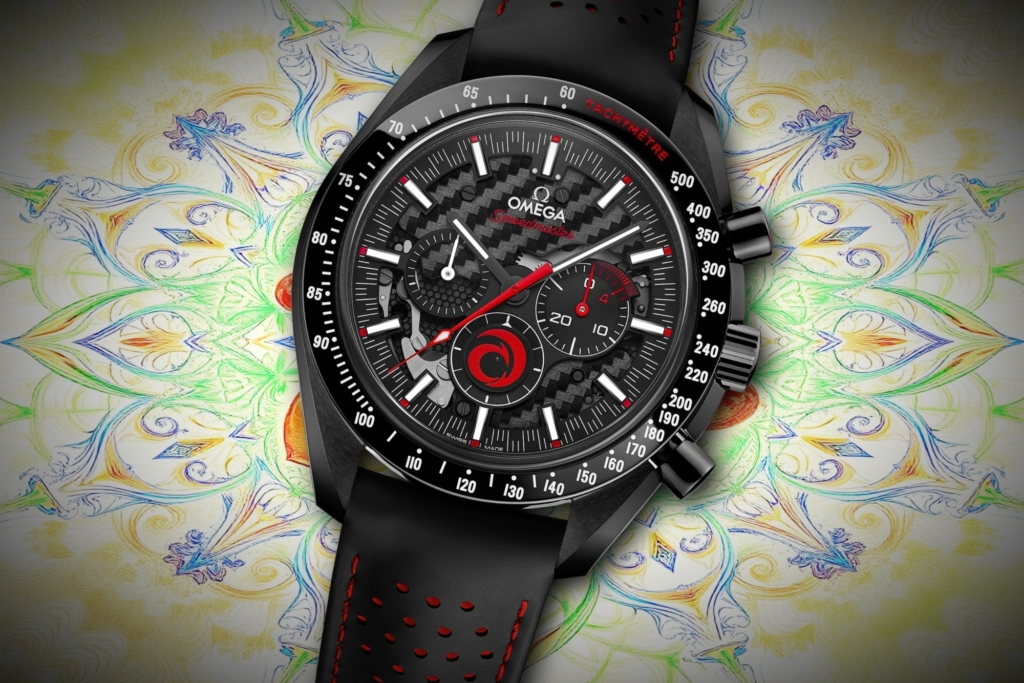
That woven laser-etched pattern continues onto the dial. Meanwhile, the Apollo 8 has an interesting moon-like dial texture.
There are three main ways to tell the newer Master Chronometer-certified version of the Apollo 8 from the original: “Tachymètre” is in white (originally it was yellow), the running seconds hand is a tiny Saturn V rocket, and it has a folding clasp instead of a simple tang buckle. Plus you’ll see the newer 3869 movement if you look at the newer version from behind, but it doesn’t look much different than the 1869 it replaced.
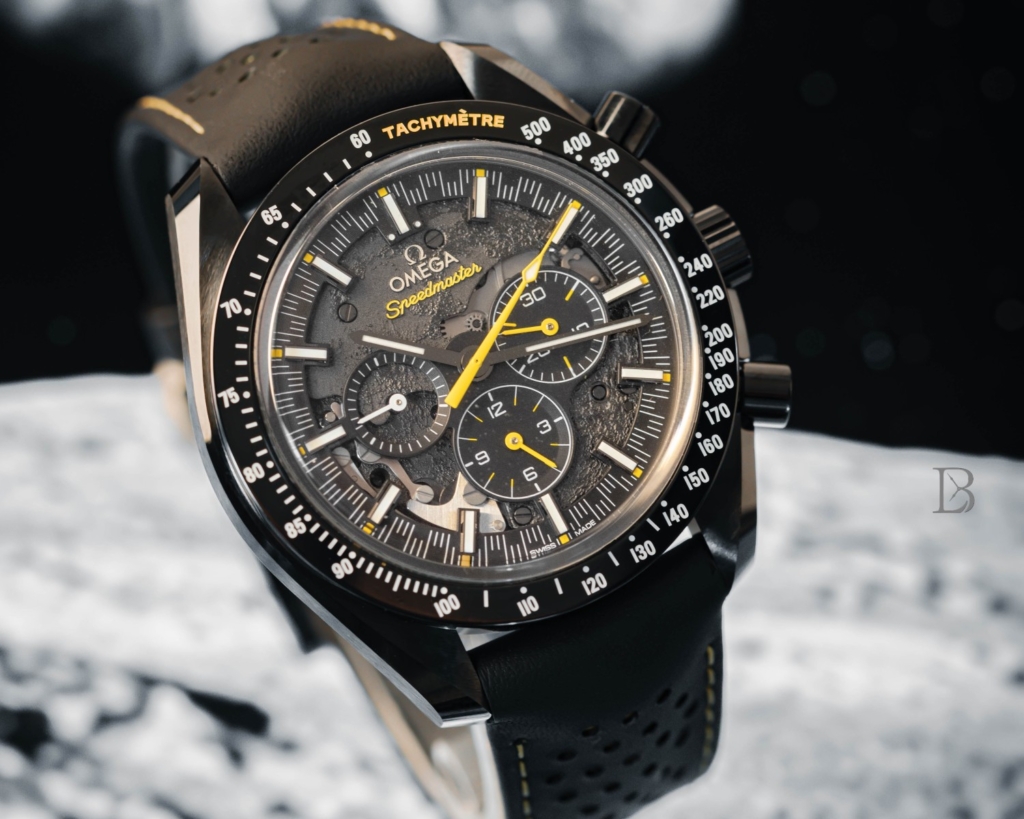
Grey Side of the Moon Speedmaster
To make the Grey Side of the Moon, which appeared in 2014 only one year after the original Dark Side of the Moon, Omega starts with a base of white zirconium oxide ceramic and then puts it through a plasma treatment. In this process, the ceramic is fired in a plasma reactor at extremely high temperatures (around 20,000°C), where gases like hydrogen, methane, and argon bombard the surface.
This causes a chemical transformation from zirconium oxide to zirconium carbide, changing the color to a metallic grey without adding any metal. The result is a material that’s just as scratch-resistant and resilient as black ceramic, but with a metal-like sheen that can be brushed or polished. The Dark, White, and Blue Side of the Moon models are all just colors of zirconium oxide. So in a way the Grey Side of the Moon is the most special.
First-Generation Grey Side of the Moon
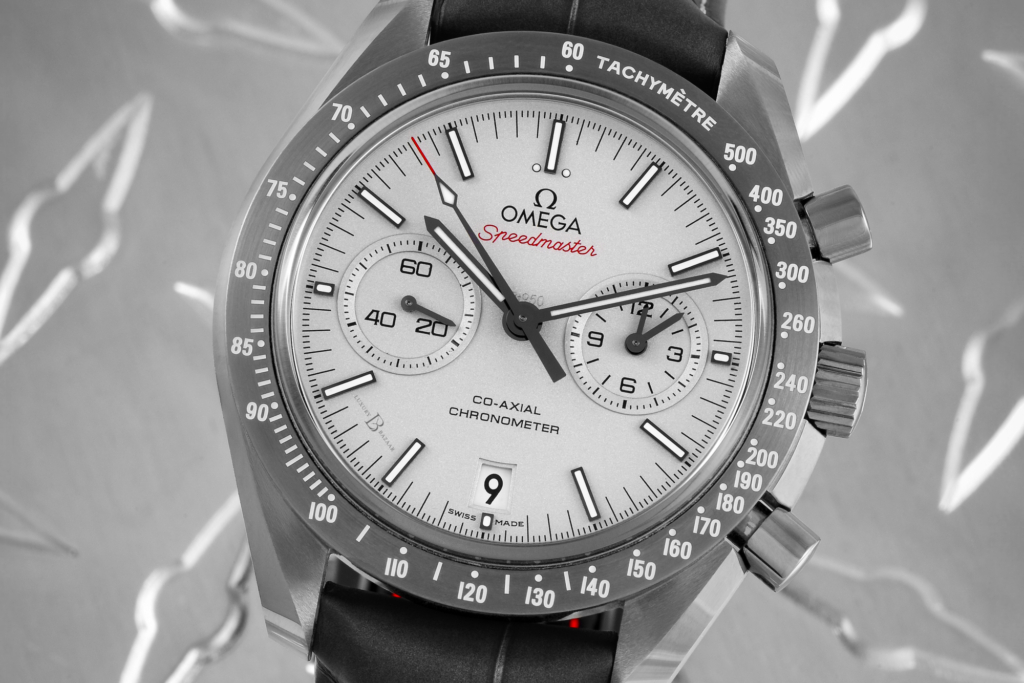
The standard dial for the original Grey Side of the Moon was made out of .950 platinum. A version with a meteorite dial and Sedna gold bezel entered the lineup in 2022. The meteorite GSOTM’s final list price was $18,000 in 2025 before getting discontinued. Like the Dark Side of the Moon, the first Grey Sides were given automatic two-register chronograph movements with the date at 6 o’clock.
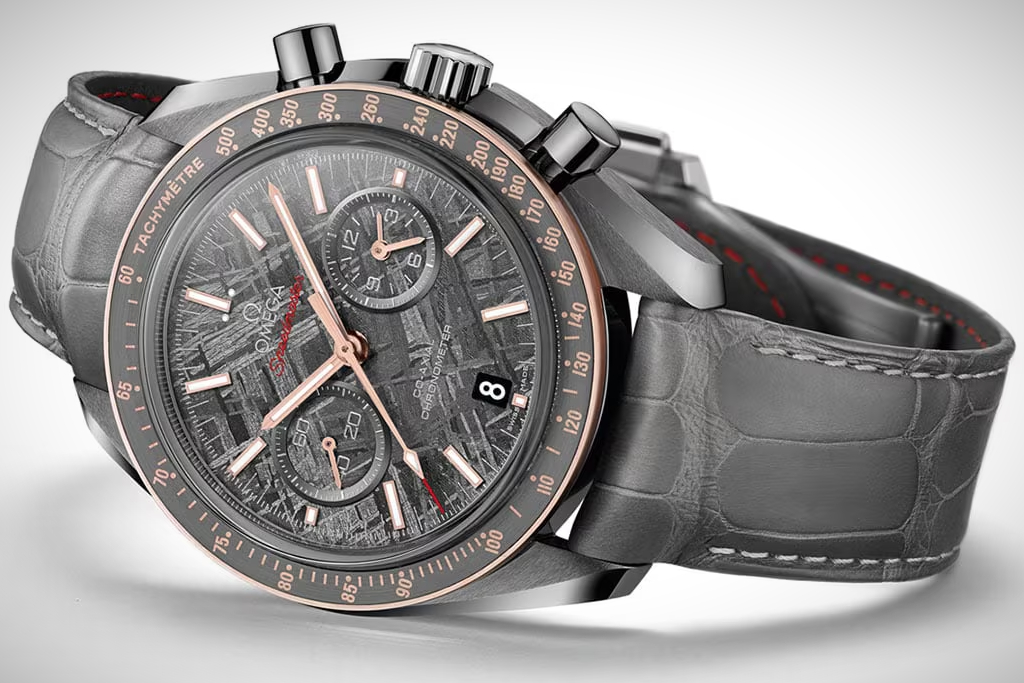
Second-Generation Grey Side of the Moon
For the second generation of Grey Side of the Moon models, released in October 2025 along with the updated Dark Side models, Omega took the lineup in a different direction, making it more like the Apollo 8 DSOTM.

That means a partially openworked laser-etched moon-pattern dial, and a manual-wind three-register chronograph movement. There are no more meteorite or platinum dials, but this new dial texture–which matches that of its impressive 3869 movement–will likely sell well. Although I do expect some discounts off the $16,400 list price to be had. The second-generation Grey Side of the Moon is available either on a grey nylon or grey rubber strap, both with folding clasps.
More on Omega:

Omega White Side of the Moon Speedmaster
The Omega Speedmaster White Side of the Moon first appeared in 2015, the year after the Grey Side debuted. And it is white. Everything except the black text and numbers (and red “Speedmaster” text) is crispy white. Functionally it’s just like the Dark Side and Grey Side.
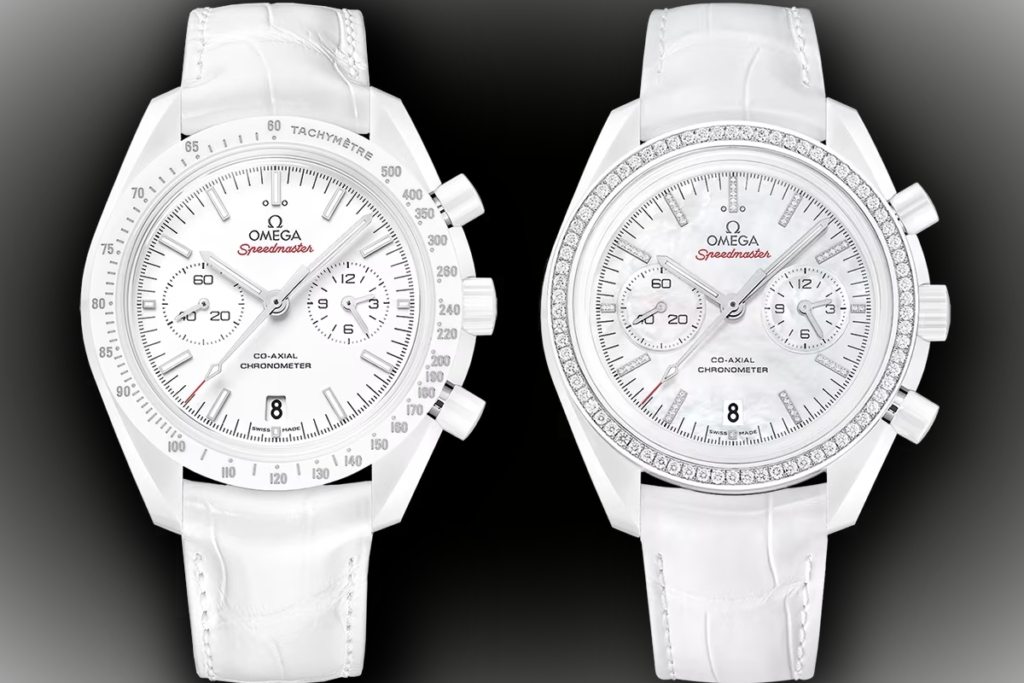
There’s also a little-discussed version of the WSOTM with a mother-of-pearl dial and a diamond-set bezel. The design isn’t very manly, and the 44.25mm width isn’t very feminine, so perhaps that’s why it didn’t get much love. It’s an interesting watch though.
Blue Side of the Moon Speedmaster
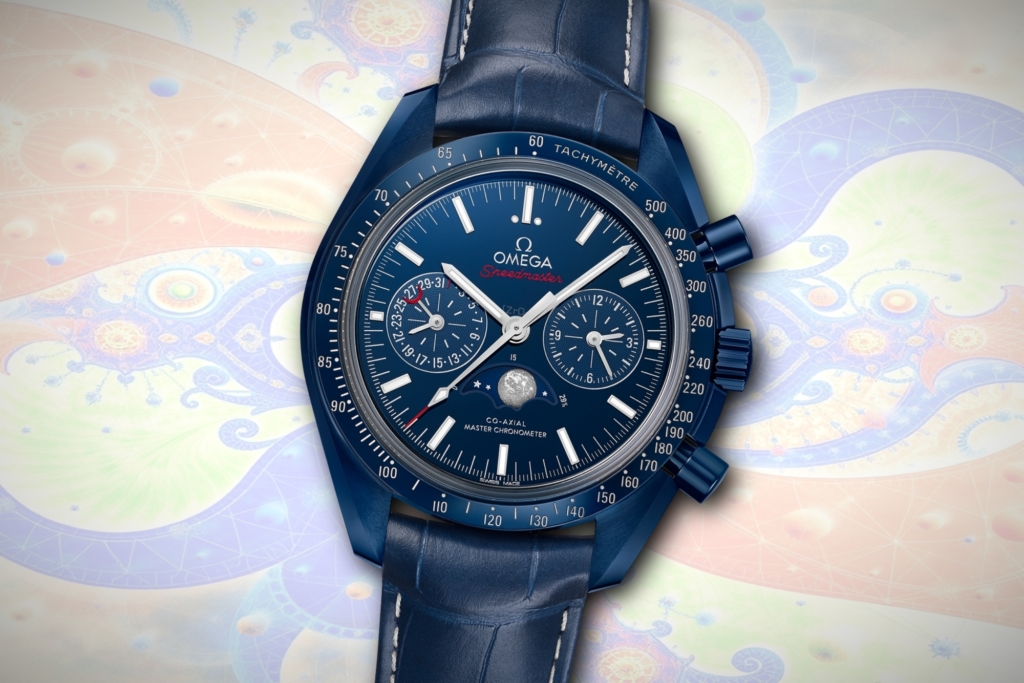
The Blue Side of the Moon Speedmaster first appeared in the Omega catalog in 2017, with a new Caliber 9904 movement featuring a moonphase indicator at 6 o’clock, along with a clever pointer date indicator added to the running seconds indicator at 9 o’clock. A beautiful aventurine glass dial option debuted one year later with gold accents (and a golden moon) instead of silver.
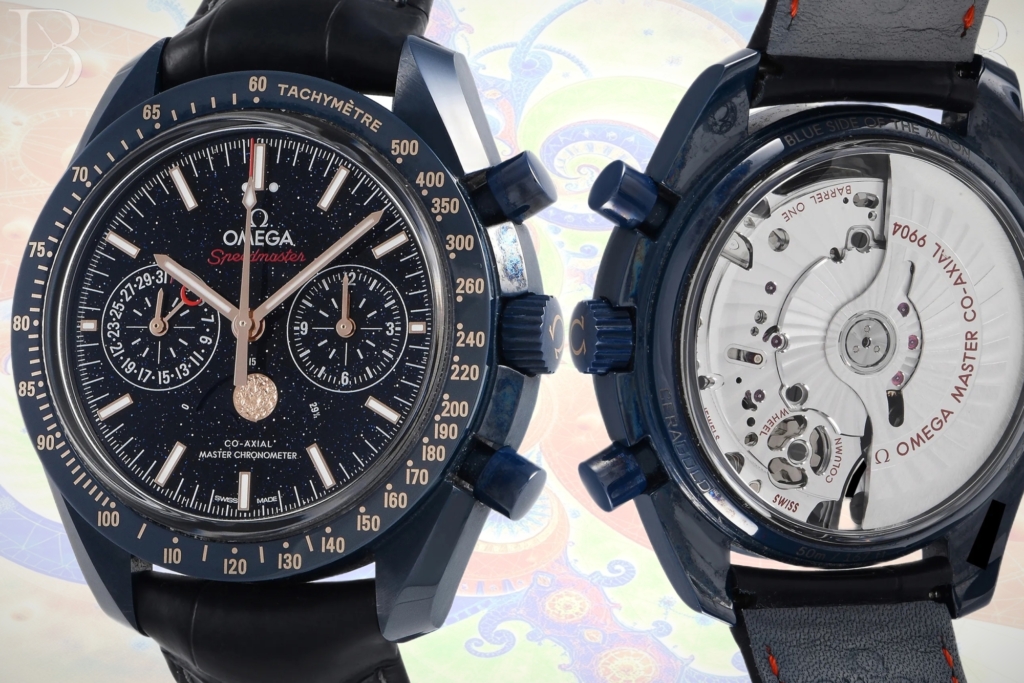
Note that technically Omega considers the Blue Side of the Moon separate from the Dark Side of the Moon family, but they’re all 44.25mm ceramic Speedmasters so to me they go together. The Blue Side of the Moon and the newer version of the Dark Side of the Moon Apollo 8 were the first of the lineup to get Master Chronometer certification, and the current offerings all have it.
Omega Speedmaster Dark Side of the Moon Price
Most variations of the Omega Speedmaster Dark Side of the Moon, Grey Side of the Moon, White Side of the Moon, and Blue Side of the Moon Speedmaster released before 2025 can be purchased secondhand for roughly $8,500. The three exotic dial options–meteorite for the Grey Side of the Moon, mother-of-pearl for the White Side of the Moon, and aventurine glass for the Blue Side of the Moon–will put the price closer to $12,000.
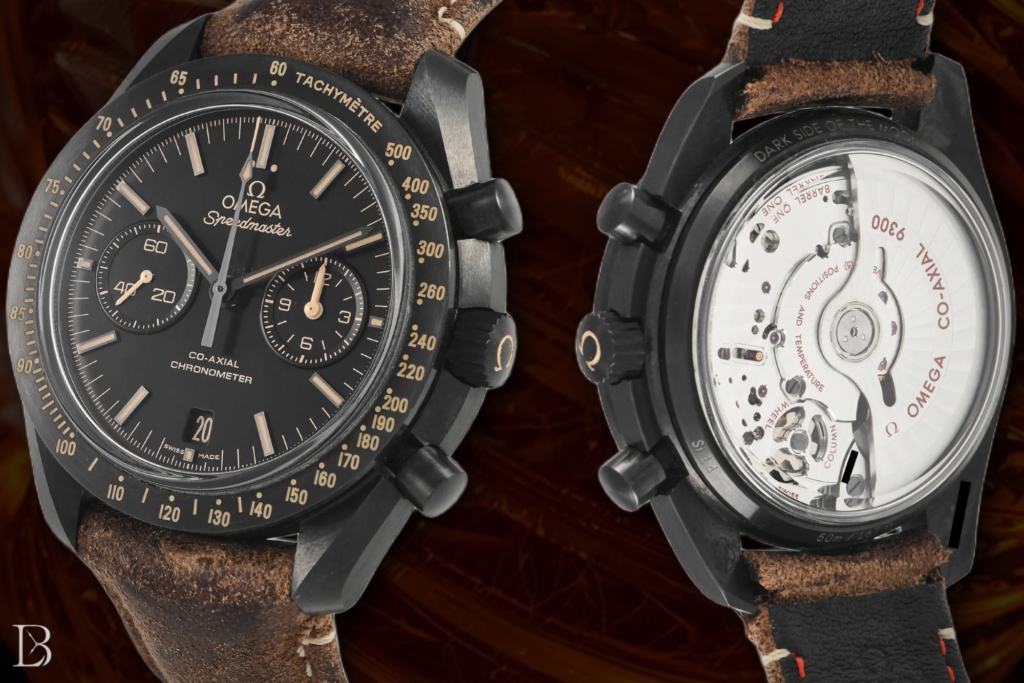
The newer version of the Dark Side of the Moon Apollo 8 goes for about $11,000 and that’s probably roughly what most of the second-generation Side of the Moon models (which have list prices between $15,700 and $16,400) will end up going for pre-owned.
Now we’ll go over a timeline of all the DSOTM models. Note that if there are two references listed for the same model, those are differences in straps (namely tang buckle vs. folding clasp for older models, or rubber vs. nylon strap for newer ones). Folding clasps first appeared in the lineup on the Blue Side of the Moon in 2017, and they’re now standard across the lineup.
Omega Speedmaster Dark Side of the Moon Models
| Debut Year | Model | Distinguishing Features | Reference Number(s) |
|---|---|---|---|
| 2013 | Dark Side of the Moon (Original) | All-black zirconium oxide ceramic, Co-Axial 9300 movement, red “Speedmaster” text, black nylon strap, replaced with upgraded model in 2025 | 311.92.44.51.01.003 311.92.44.51.01.007 |
| 2014 | Grey Side of the Moon (Original) | Grey plasma ceramic case and matching dial, grey leather strap, limited edition with Porsche Club of America caseback engraving released in 2017 | 311.93.44.51.99.001 311.93.44.51.99.002 311.92.44.51.99.001 (PCA) |
| 2015 | Black Black | Matte black ceramic, all-black accents (indices, subdials, hands, markers), black nylon strap, replaced by Dark Black in 2025 | 311.92.44.51.01.005 |
| 2015 | Pitch Black | Black ceramic, bright accents, luminous bezel markings, white “Speedmaster” text, discontinued in 2025 | 311.92.44.51.01.004 |
| 2015 | Sedna Black | Black ceramic with Sedna gold bezel and accents, discontinued 2025 | 311.63.44.51.06.001 |
| 2015 | Vintage Black | Black ceramic, tan accents, light brown vintage-inspired leather strap, discontinued 2025 | 311.92.44.51.01.006 |
| 2015 | White Side of the Moon | White ceramic case and dial, crisp black lettering on the bezel, white leather, discontinued 2025 | 311.93.44.51.04.002 |
| 2015 | White Side of the Moon with Diamonds | As above but with diamond-set bezel and mother-of-pearl dial, discontinued 2025 | 311.98.44.51.55.001 |
| 2017 | Blue Side of the Moon | Blue ceramic case and dial, white and silver accents | 304.93.44.52.03.001 |
| 2018 | Blue Side of the Moon Aventurine | Blue ceramic case and dial, blue aventurine glass dial, Sedna gold accents | 304.93.44.52.03.002 |
| 2018 | Apollo 8 (Original) | Black ceramic, partially skeletonized dial, lunar motif, manual wind Cal. 1869, discontinued 2024 | 311.92.44.30.01.001 |
| 2020 | Speedmaster Alinghi | Black ceramic, red accents, partially skeletonized checkerboard dial, rotating Alinghi logo acts as chrono hour hand | 311.92.44.30.01.002 |
| 2022 | Grey Side of the Moon Meteorite | Meteorite dial and Sedna gold bezel | 311.63.44.51.99.002 311.63.44.51.99.001 |
| 2024 | Apollo 8 (2nd Generation) | Manual-wind Cal. 3869, Saturn V rocket hand, revised skeleton/lunar motif | 310.92.44.50.01.001 |
| 2025 | Dark Vader | “Dark Red” model with Master Chronometer movement, red seconds hand, black fill on the hands/markers, no date, black-coated manual-wind movement, only offered on rubber | 310.92.44.51.01.001 |
| 2025 | Dark Side of the Moon (2nd Generation) | Step dial, more recessed subdials, Master Chronometer movement, rubber strap now an option | 310.92.44.51.01.002 310.92.44.51.01.004 |
| 2025 | Dark Black | Effectively replaced the Black Black, step dial, more recessed subdials, Master Chronometer movement, rubber strap now an option | 310.92.44.51.01.003 310.92.44.51.01.005 |
| 2025 | Grey Side of the Moon (2nd Generation) | Grey ceramic, partially skeletonized dial, lunar motif, manual wind Cal. 3869 | 310.92.44.50.06.001 310.92.44.50.06.002 |
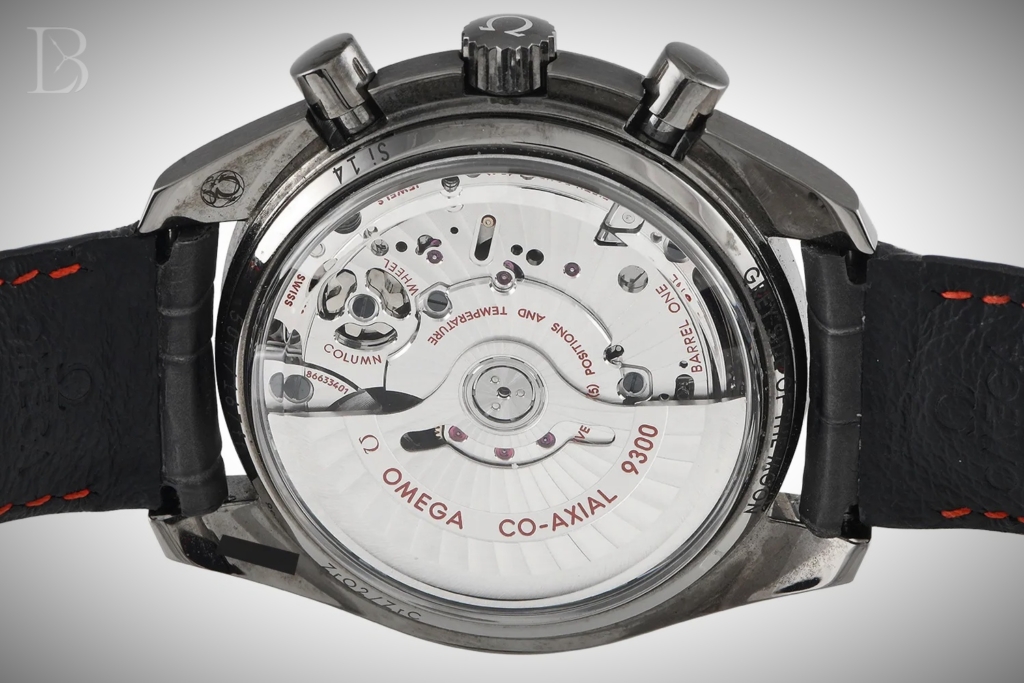
Future of the Lineup
While I thought the second generation of Omega Dark Side of the Moon models might shrink to the 43mm size of other recent two-register Speedmaster models, it seems the lineup is destined to live on at its 44.25mm size. And by getting rid of the White Side of the Moon, Sedna Black, and Vintage Black, while effectively replacing Pitch Black with Dark Vader, I think the DSOTM lineup is no longer hopelessly oversaturated. Good job, Omega–let’s see if it stays that way!
More on the Omega Speedmaster:

One response to “A Look at Every Omega Dark Side of the Moon Speedmaster”
-
Nice overview.
I remember going into my local Omega dealer to buy a regular Speedmaster and being underwhelmed. I never heard of this range but tried on the “Vintage” and was impressed. I did some research and settled on the Meteorite which I now have about two years. I still think it’s gorgeous.
A while afterwards I tried on the blue with aventurine dial. Again, absolutely gorgeous but I restrained myself.

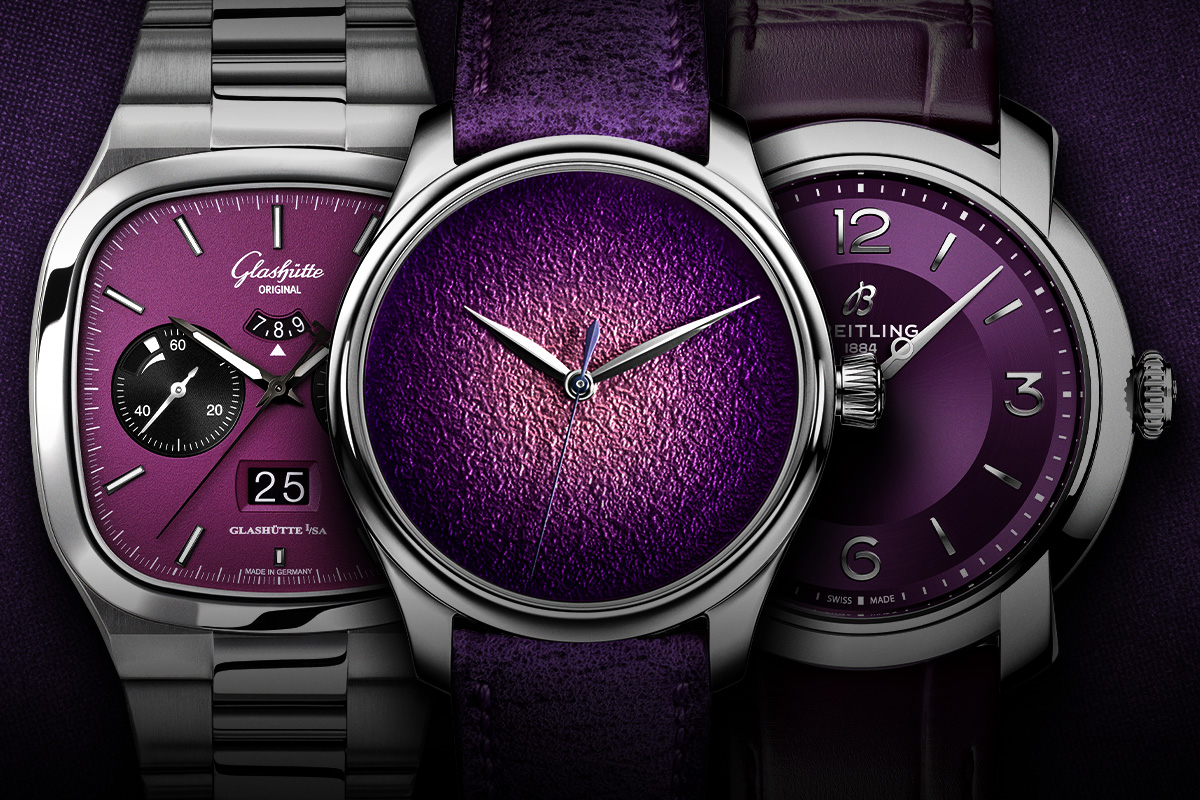
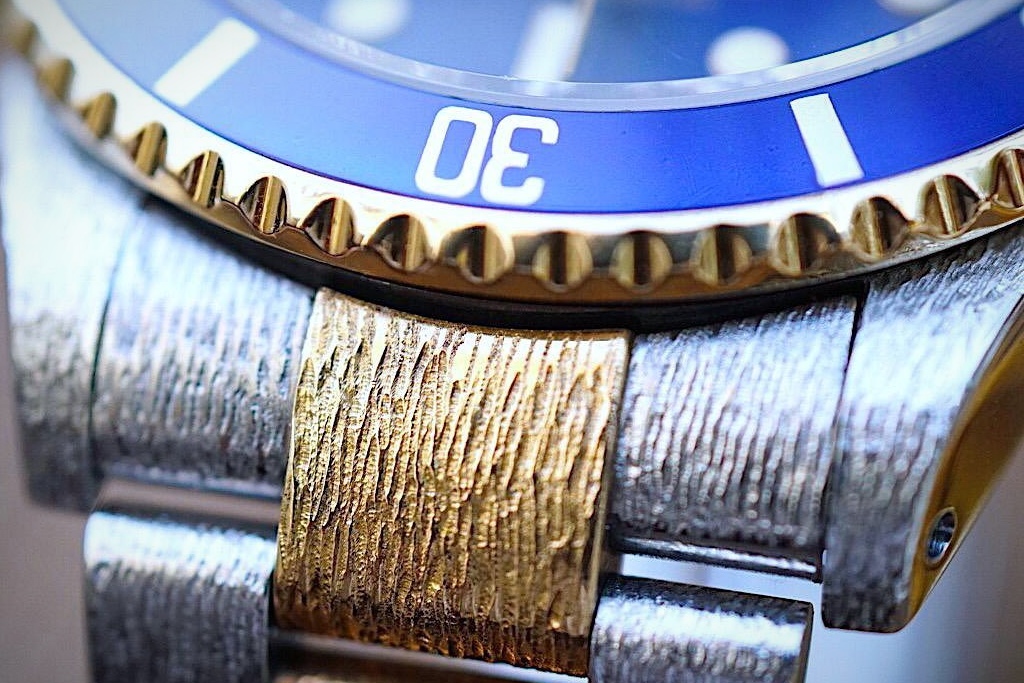
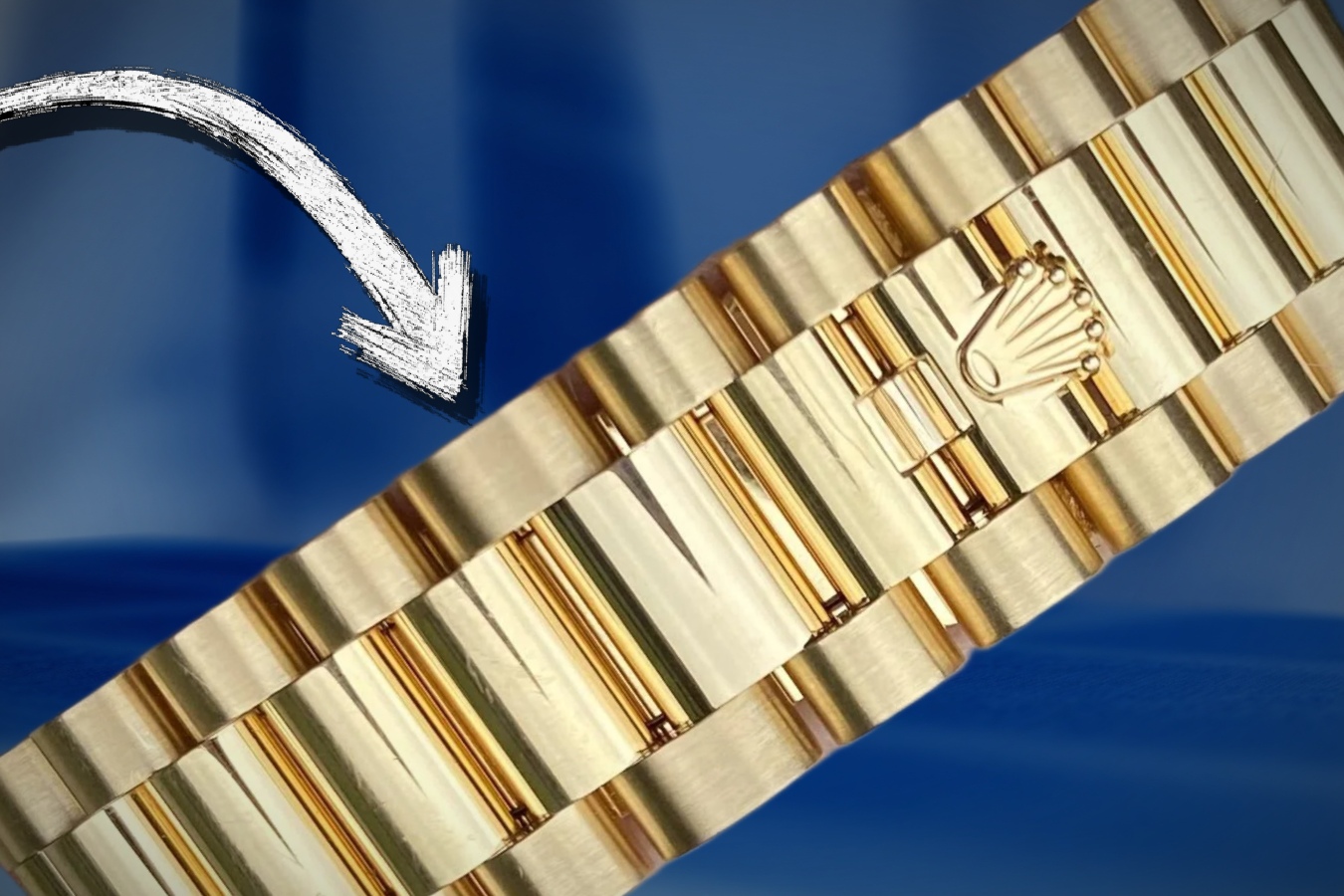


Leave a Reply